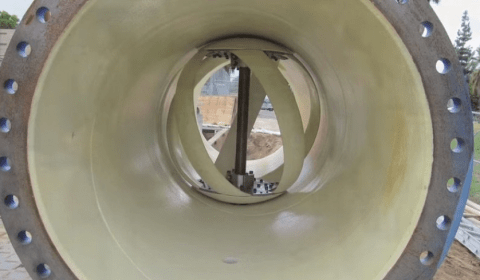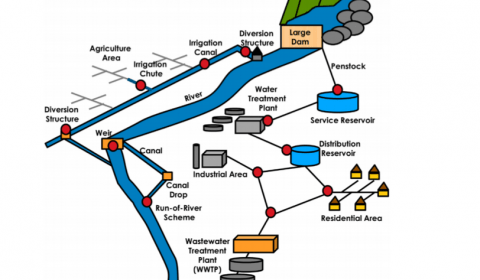Water-to-wire Micro-hydropower generation could provide a smart solution to achieve a greater energy-water nexus

The concept of kinetic energy was discovered ages ago. The world’s waterways are filled with kinetic energy as gravity draws water across watersheds, through waterfalls and rivers that flow into the sea. Humans have explored ways to harness energy from water for centuries which started off as extracting energy in water to turn water wheels and power agricultural machinery. In the 19th century, the inherent capacity of water was explored to generate electricity. Today, hydropower generation creates images of massive landscape shattering dams such as the Hoover Dam on the Colorado River. Hydroelectricity is produced when water falls from a height onto a turbine that rotates underwater. The turbine moves to convert the kinetic energy of water into electricity. While hydroelectric dams produce enormous amounts of electricity, there have been reports of these projects swallowing up natural and human habitats during their implementation.

While the merits of large hydroelectric projects dominate over their demerits, a new school of thought is advocating generation of “in-stream” electricity instead. Clearly, the focus has shifted from grand dams to instream (or in conduit) turbines that function similar to a traditional water wheel. These turbines are placed within a flowing stream with minimal structural support and no barriers, diversions or storage required. Even though water flow patterns can shift based on seasons and time, microturbines are thought to provide a continuous ‘stream’ of energy. These systems are currently used to generate 5-100 kilowatt (kW) power. An in-stream micro-hydro system contains 5 components1: (i) A water channel, river, stream, pressurized water or other types of water conveyance that delivers water; (ii) Equipment such as a turbine or waterwheel that converts the kinetic energy of water into rotational energy; (iii) An alternator or generator that converts rotational energy into electricity; (iv) A control system to regulate generator function; (v) Wiring that delivers electricity.
Even though in-stream hydropower systems can be built for a cost as low as $1,000 – $20,0002, the pros and cons micro hydropower must be considered before implementing these systems. These systems are highly efficient, feasible even at a flow rate as low as two gallons per minute or a drop of 2 feet. The micro-hydro systems offer a reliable source of power in comparison to other small-scale technologies like solar. Developing countries can implement these projects in villages and rural areas where electricity is not accessible. However, these systems also come with their own disadvantages. The water flow can be very low in the summer months which can create a hurdle to electricity generation. Stream water is diverted away from a portion of the stream, and proper caution must be exercised to ensure that there is no damage to the local ecology, habitats or civil infrastructure.

Another variation of the micro-hydro system is “in-conduit” electricity generation which has a higher generation potential than “in-stream’ systems. To generate conduit hydropower, existing tunnels, canals, drinkingwater pipelines, sewers, aqueducts, outfalls and other manmade structures that carry water are fitted with electric generating equipment. These projects often qualify as small hydro and are capable of extracting power from water without the need for a large dam or reservoir. The in-conduit hydropower systems are also eligible for renewable energy incentives in certain US states. Water conduits have a large untapped potential to recapture energy for small hydroelectric generation, which can substantially reduce grid electricity consumption and/or provide renewable energy to water agencies. In-conduit systems can generate 100-10 MW electricity. The city of San Diego has implemented a project to generate 4.5 MW of clean and reliable power.
Adoption of small hydropower systems in water and wastewater utilities remains limited due to market penetration and exposure despite the intricate link between water and energy, especially in engineered systems. Since water pumping in these conduits is an energy-intensive process, tapping into the kinetic energy of water to run these pumps offers an energy-efficient solution. Several recent studies have indicated that the cost of small-scale hydro systems is comparable to large scale electricity generation4.
If planned and implemented properly, these systems act as ‘microgrids’ and help conserve national grid electricity to a great extent. These microgrids can function stand-alone entities or be integrated with the larger grids offering a great deal of flexibility. Further, utilities can save significant energy cost by implementing these systems and move toward a more sustainable and decentralized economy. These small-scale power generators can also be integrated with other forms of renewable energy such as solar, wind, and waste to energy resulting in significantly lower energy-related greenhouse gas emissions. The micro hydropower systems also present opportunities for integration of power and water utilities and hence improve the linkage between energy and water to a greater extent.
- https://www.alternative-energy-news.info/micro-hydro-power-pros-and-cons/ ↩
- https://www.energy.gov/energysaver/buying-and-making-electricity/microhydropower-systems ↩
- Swindle, M. et al. Recent innovations and trends in in-conduit hydropower technologies and their applications in water distribution systems. J. Environ. Manage. 228, 416–428 (2018). ↩
- Swindle, M. et al. Recent innovations and trends in in-conduit hydropower technologies and their applications in water distribution systems. J. Environ. Manage. 228, 416–428 (2018). ↩

